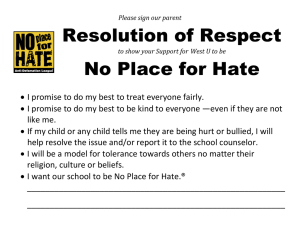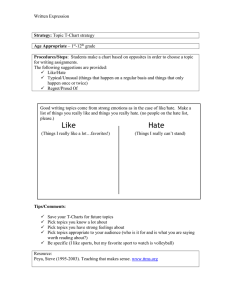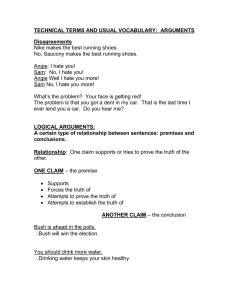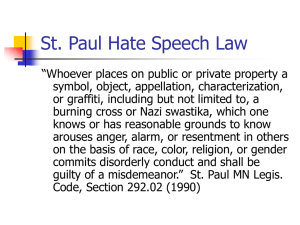Erase the Hate: Work for Tolerance
advertisement
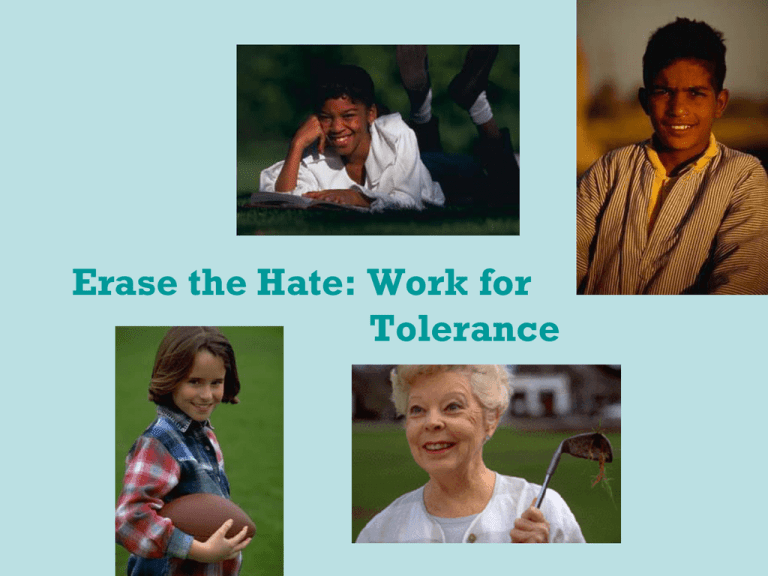
Erase the Hate: Work for Tolerance Some of the goals of Healthful Living Education are to . . . – Define tolerance – Explain why tolerance is important to a healthy society – Demonstrate respect for differences and diversity These words help us understand tolerance. What do they mean? Which ones are opposites of each other? Bias Judgmental Acceptance Nondiscrimination Bigotry Harmony Discrimination Equity Exclusion Peace Hate Respect Stereotyping Social justice Inclusion On what basis are groups and individuals the targets of hate, stereotyping, and discrimination? Brainstorm responses, then see next slide for possible answers. Groups and individuals are targets of hate based on . . . Race/ethnicity Gender Religion Sexual orientation Geography/socioeconomic status Labels (such as “jocks,” “geeks,” “granolas”) Disability or health status Age Hate crime: when bias motivates an illegal act Somewhere in America, every hour, someone commits a hate crime. Brainstorm some ways that hate is expressed within our society . . . [See next slide for answers.] How Hate is Expressed •Name-calling and gossip •Physical Injury •Bullying •Exclusion •Teasing or put-downs •Threats •Vandalism •Murder •Torture •Rape •Slurs •Hate Literature The Southern Poverty Law Center counted 1,018 active hate groups in the United States in 2011. (Only organizations and their chapters known to be active during 2011 are included.) Bias Incidents are actions motivated by hate (speech, conduct or expression) yet no crime is committed. In order to promote tolerance, one has to act in the face of hatred. Silence or inaction can be viewed as support or encouragement for acts of hate, prejudice, or bias. Scenario #1 Recently, a church, a synagogue, and a mosque in one city were badly vandalized. The exterior walls were defaced with graffiti, windows were broken, and parts of all three buildings were damaged by fire. The community is devastated by the intentional destruction to three well known places of worship. Questions about Scenario #1 • Is this vandalism an example of a hate crime? • How are hate crimes different from other crimes? • What does religious freedom mean in a democracy? Scenario #2 Two boys in your class are in the academically gifted program. They are very bright, interested in advanced technology and computer programming. These young men are not especially athletic. They are sometimes teased about not being masculine and called “the geek squad” or “nerds r us.” One of the boys is your cousin and your family asks you to look out for him and tell a teacher if he is harassed. Questions for Scenario #2 • Why might students feel it is acceptable to tease someone physically weaker than themselves? • How would you feel if you were the target of similar put-downs because of your intelligence or a talent that was not appreciated and respected by others? • What will you do if you witness these students being teased in the future? Scenario #3 A new student moves to the local middle school and she speaks French. She is learning the English language but is still having some difficulty communicating with teachers and her classmates. During lunch, students refuse to let her sit at their tables and some throw French fries at her and tease her by calling her “Frenchie.” Many students speak slowly and loudly to her, as if she is hard of hearing or intellectually challenged. They tell her to learn English or go home. She feels so isolated and alone. Her parents were relocated to this community because of their international jobs. She is not sure she can take this teasing any longer. Questions for Scenario #3 • Why do people discriminate against others because of their race, ethnicity, or nationality? • How would you feel if you were bullied because of your native language? • How can students stand up for others who are mistreated because of their race, ethnicity, or nationality? Scenario #4 All school buses at Grant Park Middle School have bus monitors. Many of the monitors are retired bus drivers or retired educators who enjoy working with children and are volunteering to help keep children safe on the school bus routes. Students on Bus #31 are cruel to Mrs. Smith, who serves as the monitor of their bus. They consistently set up pranks to humiliate her. They tease her because of the clothes she wears and make fun of her thick glasses. They talk to her in really loud voices pretending she is hard of hearing and make faces and rude gestures behind her back. One student recently told her that she was ancient and needed to go monitor the dinosaurs at the science museum where she belonged. Questions for Scenario #4 • Describe what is meant by the term ageism. Give examples of how ageism is expressed. • How do you interact with older persons, such as grandparents, neighbors? • What can be done to improve relations between generations? Scenario #5 Mario and Cassandra have been working at the local park as youth sports directors for 5 years. They are both talented and well respected by their peers and the athletes they serve. A regional director position has become available and the interview team selected Mario and not Cassandra. They were worried that Cassandra might be too emotional to handle the stressful decisions required of a regional director. Questions for Scenario #5 • Do you think men and women should have equal opportunities in the work force? Give examples. • Why have gender inequities occurred in the past? • What can we do to make certain both genders are treated equitably and with respect? Scenario #6 Your county has one high school and two middle schools. It is quite an adjustment for the students to come together in the ninth grade. Students from rural areas of the county are thought to be “rednecks” and students from town are considered stuck-up and “preppie.” You have friends from both groups who tease you when you hang out with others. Questions for Scenario #6 • Why might people who live in different geographical areas be judgmental towards others? • People who work for social justice say that humans have much more in common than they have differences. List some examples that this statement is true. • How can you, as an individual, work toward all people being treated with dignity and respect? The following slide cites a pledge for tolerance that was adopted by a school in Washington. • What do you think of the pledge? • Could your school work toward the concept of respect for all? How? Respect is the cornerstone of all our interactions and behaviors. We acknowledge the dignity and worth of one another and strive never to diminish another by our conduct or our attitudes. Mariner High School Everett, Washington
